The Affair of Ares and Aphrodite
In the previous article concerning the Greek myth of Phaethon, it was revealed that the story was specifically constructed to encode a destructive planetary alignment that occurred in 687 BC. All of the key features of the story being very carefully chosen, including certain background constellations, such as Scorpius and Eridanus.
The story of Phaethon is however not the only Greek tale to encode such a planetary configuration. Yet another, also well worthy of note, is the tale of the infamous affair between Ares and Aphrodite.
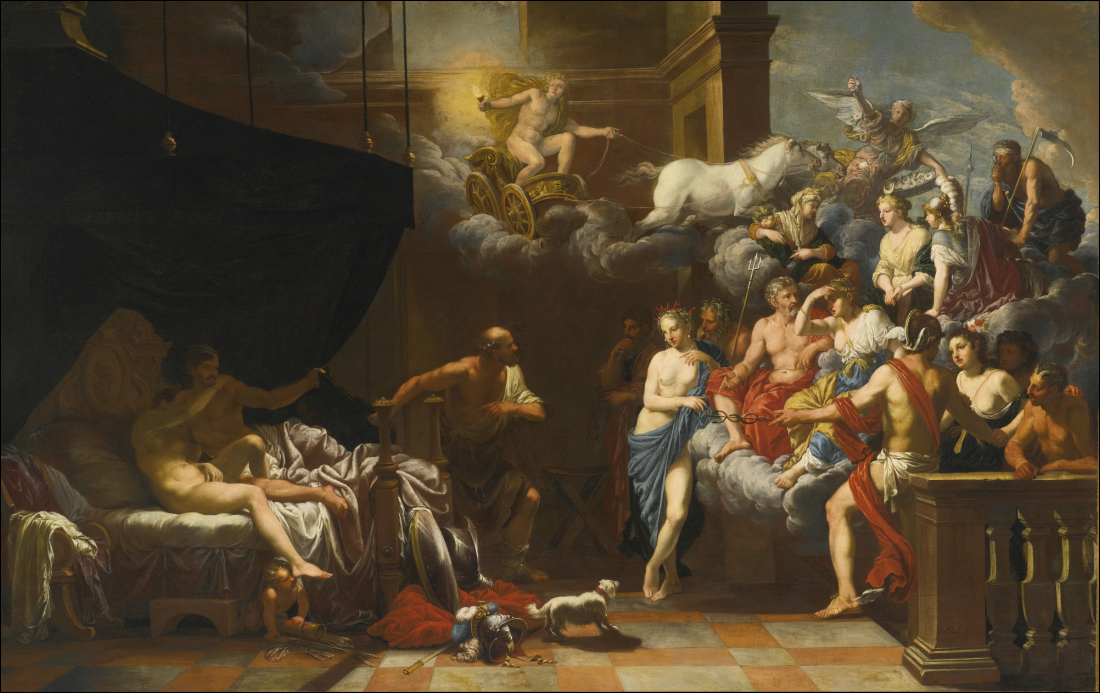
Ares and Aphrodite: An Illicit Affair
The passionate affair between Ares, the god of war, and Aphrodite, the goddess of love, was one of the most scandalous tales of Olympus. Though Aphrodite was married to Hephaestus, the skilled but unattractive smith-god, she was irresistibly drawn to Ares’ strength and fiery spirit. Their secret trysts were many, but none could remain hidden forever—especially not from the all-seeing Sun.
One day, as the Sun god Helios drove his chariot across the sky, his piercing gaze fell upon the lovers entwined in Aphrodite’s chamber – a union of passionate embrace. Disgusted by their betrayal, Helios went straight to Hephaestus and revealed what he had witnessed. Furious, the cunning smith plotted his revenge. In his workshop, he forged invisible, unbreakable chains—a net so fine that no eye could detect it. He draped it over Aphrodite’s bed and pretended to leave for his forge.
As soon as Hephaestus was gone, Ares and Aphrodite rushed into each other’s arms—only to be trapped mid-embrace by the enchanted net. Hephaestus burst in and summoned all the Olympians to witness their shame. The gods laughed at the spectacle, though some—like Hermes and Apollo—joked they would gladly take Ares’ place. Humiliated, the lovers were freed only after Poseidon intervened, promising Ares would pay a fine. This was far from the end of the matter however. Furious at Helios for exposing her, Aphrodite swore vengeance. She made the Sun god burn with uncontrollable desire for Leucothoe, a mortal princess of Persia.
Distracted by his passion, Helios grew erratic – sometimes rising too early in the Eastern sky, sometimes he was later than he should have been in plunging into the waves. Lingering to gaze at her, he lengthened the hours of the winter days. Sometimes his light failed, and the sickness of his mind affected his rays, so that he grew dim – striking terror into the hearts of mortals. It was not the moon’s orb, journeying between him and the Earth, which made him wan, by cutting off his light: Love was the cause of his pallor. All his affection was centred upon this girl alone.
Unable to resist, Helios took human form and approached Leucothoe as she sat among her twelve handmaidens, spinning wool. Commanding the maidens to leave, he revealed his divine radiance and declared his love. Leucothoe, awestruck, could not refuse him. But their secret was soon discovered by Clytie, a nymph who loved Helios and, consumed by jealousy, spread the tale to Leucothoe’s father. Enraged, the king buried his daughter alive.
Though Helios tried to revive her by bathing her body in his light, she was beyond saving. In grief, he transformed her into a frankincense tree, whose sweet fragrance would forever rise toward the sun. As for Clytie, Helios spurned her, and she wasted away pining for him, eventually becoming a heliotrope flower, forever turning her face toward the sun.
Decoding the Affair
of the Gods
One can see from the above account, that the story is in two parts. The first part concerns the affair between Ares and Aphrodite, and its exposure by the sun. The second part concerns the revenge of Aphrodite upon the sun, causing him to fall in love with Leucothoe. Now it is the second part where things get interesting, as embedded within it, are all these strange effects associated with the Sun – those which indicate some sort of upheaval within the heavens.
Although there is a narrative drama at work, both parts of the story encode two separate alignments occurring simultaneously upon a very precise date in history. And here one may cite a certain ancient scholar, who appears to have at least known some of the secrets underlying the story, and how they relate to known celestial bodies:
‘Lucian of Samosata, that most delightful writer of antiquity, the inventor of modern “science fiction,” knew how to be light and ironic on serious subjects without frivolity, remarked once that the ludicrous story of Hephaestus the lame surprising his wife Aphrodite in bed with Ares, and pinning down the couple with a net to exhibit their shame to the other gods, was not an idle fancy, but must have referred to a conjunction of Mars and Venus, and it is fair to add, a conjunction in The Pleiades.’
The above quotation is taken from the book Hamlet’s Mill by De Santillana and Von Dechend (1969). A scholarly work concerned with the origins of human knowledge and its transmission through myth.
Mars &
Venus United
Now it goes without saying that the two main gods within the story represent two prominent planets within the solar system:
Ares = Mars
Aphrodite = Venus
What Lucian is getting at with respect to the affair in question, is that when the sun witnesses the passionate embrace of Ares and Aphrodite, the sun is essentially witnessing a conjunction of Mars and Venus – from the Sun’s perspective. It is interesting to note though that Lucian mentions The Pleiades as somehow being involved. This is true, though not exactly as indicated by Lucian himself.
An alignment of Mars and Venus with the Sun – as relevant to this specific story – is in fact part of the Great World Age Ending Galactic alignment previously noted in other articles. The main component of which is an alignment of Mars, Venus, the Sun and Mercury, all targeting the Galactic centre. It is a specific instance of this alignment that is actually encoded in this particular Greek myth.
To go further, it is important also to correctly place The Pleiades within the story. And this is where the other aspect of the configuration comes into play. For at the same time as the Galactic alignment is at its optimum, there is a separate alignment ongoing between the Sun, the Earth and The Pleiades. The Pleiades is thus not a part of the conjunction involving Mars and Venus, along with the Sun and Mercury. It is something separate, though occurring at the same time.
The Sun & Moon United
The core alignment pattern i.e. The Great World Age Ending Alignment, is a pattern which has a distinct – albeit irregular – recurring cycle. The cleverness of the Greek myth concerning the affair of Aphrodite and Ares, is that it encodes a specific instance of this configuration. The question is, which instance? This is where the moon comes into the equation.
In the second part of the story, the Sun falls in love with Leucothoe, and goes off to meet her to declare his love. This involves dismissing her 12 maidservants, so that they can be alone, so the sun can embrace Leucothoe, much like Aphrodite and Ares embraced.
Who then is Leucothoe? The answer is none other than the moon. The 12 maidservants are a reference to the 12 months in a year. What the mythological story is thus encoding is an alignment between the Sun, the Moon and the Earth. And this is the key to identifying which instance of the Grand Alignment is encoded. The answer is the alignment that occurred in 627 BC:
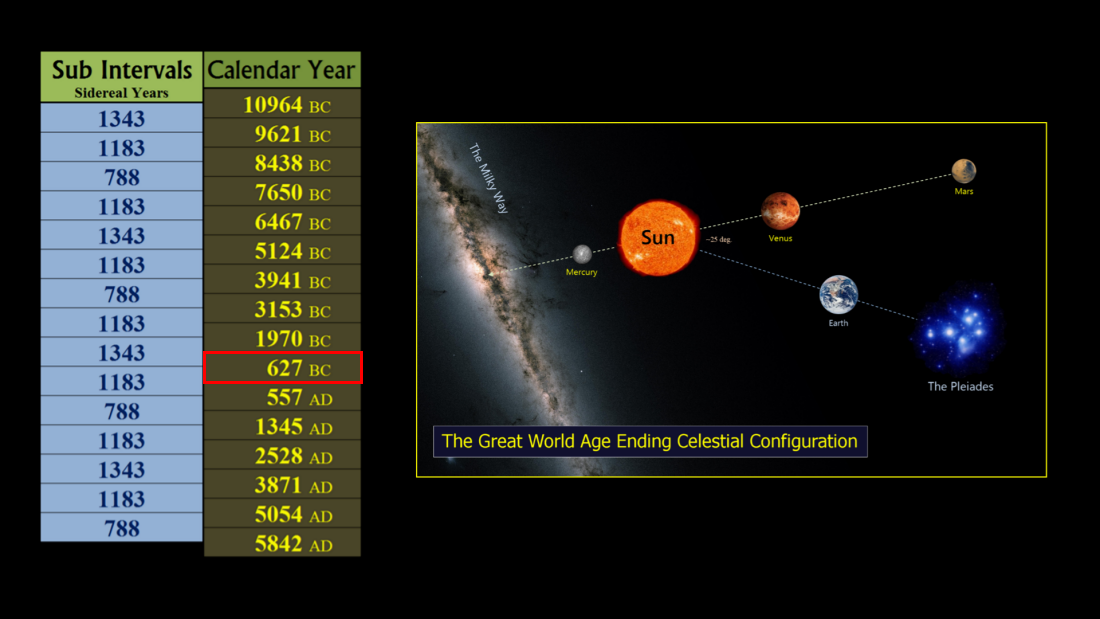
The story of Ares and Aphrodite directly encodes the 627 BC instance of the Grand Alignment. Decisive confirmation of this to be had when one examines two distinct conjunctions associated with it. Consider first a top-down view of the configuration, as optimised for the Mars-Venus-Sun component of the Galactic alignment:
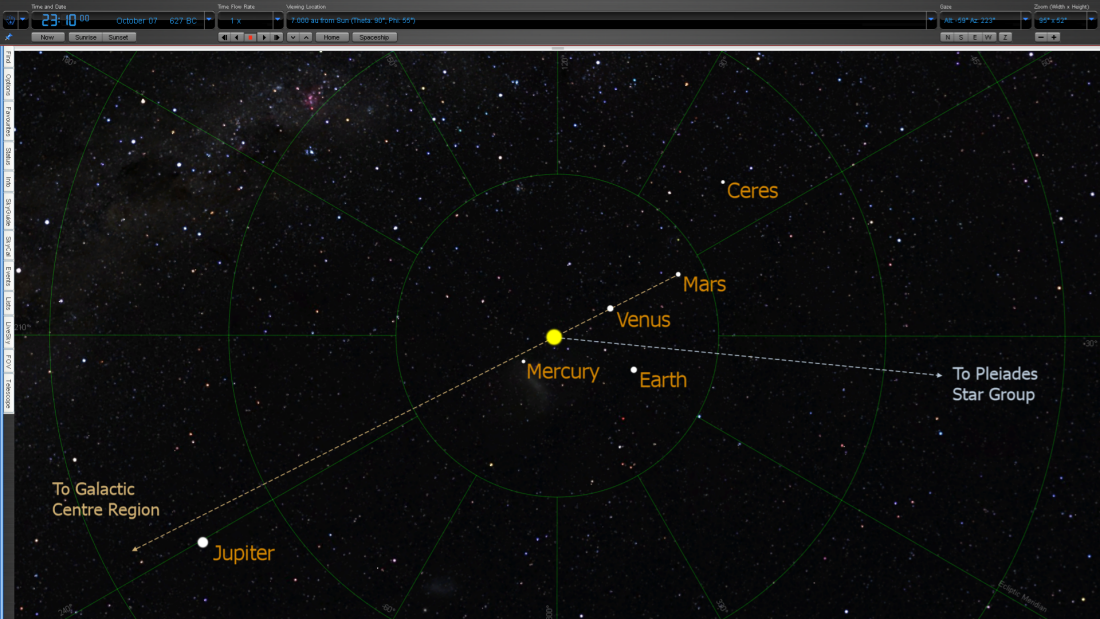
Above: One can see the precise timestamp: 7 October 627 BC, at 23:10 UTC. This is when Mars, Venus and the Sun specifically are at optimum; where Mercury is slightly offset, as shown.
One can also note the other aspect of the configuration: the Sun and the Earth closely aligned to The Pleiades. There is a slight inaccuracy here though, as all three are not perfectly aligned. That being said, the critical point to focus upon is the position of the moon within this configuration at the exact same time.
From the viewpoint of the Sun, zoomed in close to the Earth, one can see the following:
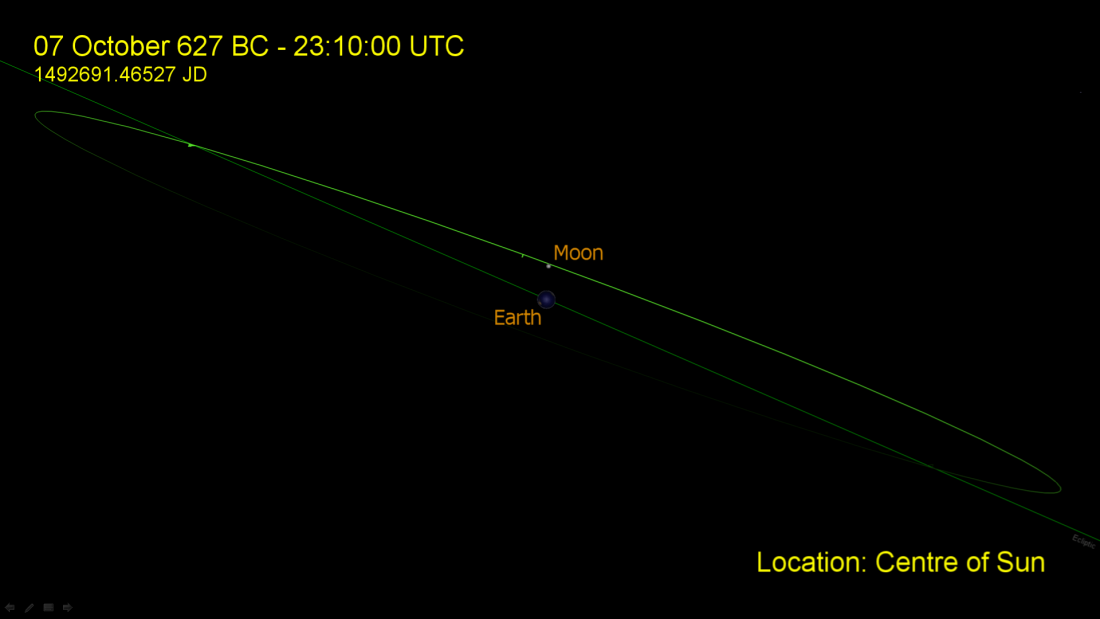
Above: The moon, being nearer to the Sun than the Earth, is in very close alignment. Exceptionally close alignment in fact. The adjustment that places it at its optimum being only 1 hour and 44 minutes away; shown as follows (Below):
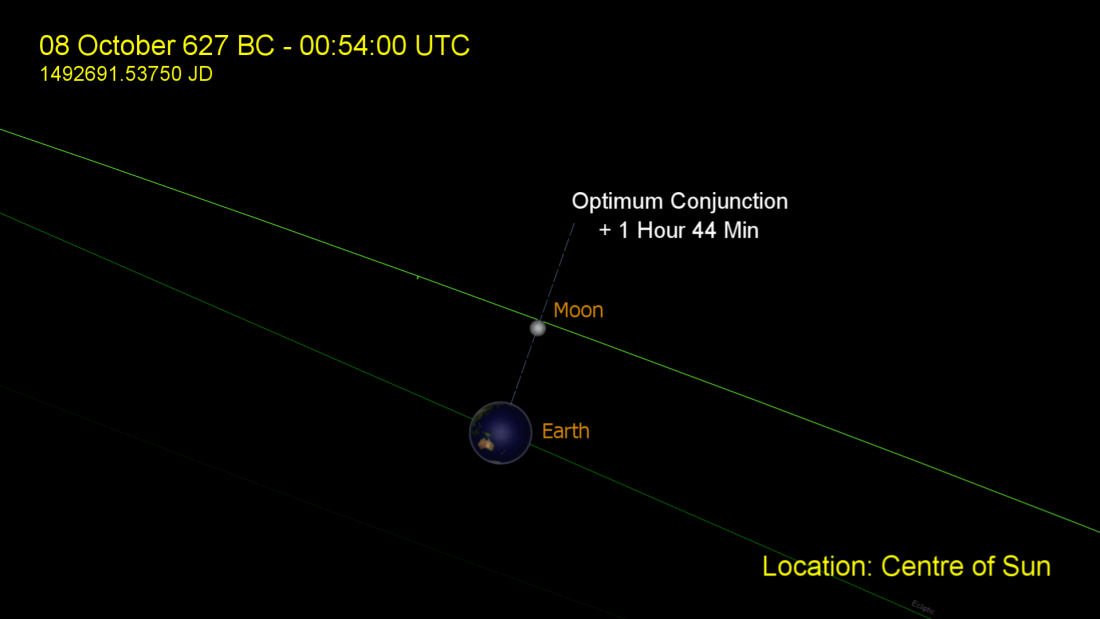
The solution to the story is clear. Both parts of the Greek myth encode the two noted conjunctions that occur almost simultaneously. The embrace of Ares and Aphrodite encodes the alignment of Mars and Venus with the Sun. The embrace of Leucothoe and Helios encodes the alignment of the Sun, the moon and the Earth.
Moreover, from the description of the Sun, as consumed with passion for Leucothoe, it is also suggested that the Earth suffered some sort of temporary disruption to its regular axial rotation. A sudden fluctuation wherein it seems to have slowed down, and then sped back up. What led to the length of the day being altered, as noted in the story.
Forecasting the 627 BC Alignment
The 627 BC alignment is an instance of the prime Great World Age Ending Alignment, and as such, the precise date of the alignment was targeted by the ancient Maya using the 1970 BC alignment of the same type as an anchor point. This being achieved through the use of the Long Count-Calendar Round system.
Now the precise mechanics of how they did this is very involved, and will be dealt with elsewhere. For now though, one may point to an easier way to target the 627 BC alignment, using an alternate world age ending conjunction. In this case, one that preceded it quite closely in time: The 23 March 687 BC conjunction, that was examined in the previous essay.
Here then, it is found that the 819-day cycle, previously shown to be linked to Noah’s Flood, is an ideal time cycle to target the 627 BC alignment. The mathematics are incredibly simple. Without any adjustment whatsoever, one can start counting units of 819 days immediately following the 23rd of March, 687 BC.
After precisely 27 such cycles are counted, one flawlessly synchronises with the 627 BC alignment:
23 March 687 BC: Phaethon Event
+ (27 × 819) =
7 October 627 BC: Aphrodite/Ares Event
Such an elegant and harmonious relationship speaks for itself.
Next: Caesar's Comet of 44 BC
Back to: Signs of the Times Menu